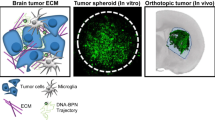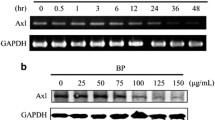Abstract
Purpose. The distribution of [3H]BCNU following release from polymer implants in the rat brain was measured and evaluated by using mathematical models.
Methods. [3H]BCNU was loaded into p(CPP:SA) pellets, which were subsequently implanted intracerebrally in rats; [3H]BCNU was also directly injected into the brains of normal rats and rats with intracranially transplanted 9L gliomas. Concentrations of [3H]BCNU on coronal sections of the brain were measured by autoradiography and image processing. For comparison, the kinetics of [3H]BCNU release from the p(CPP:SA) polymer discs into phosphate-buffered saline were also measured.
Results. High concentrations of BCNU (corresponding to ~1 mM) were measured near the polymer for the entire 30-day experiment. The penetration distance, defined as the distance from the polymer surface to the point where the concentration of [3H]BCNU in the tissue had dropped to 10% of the maximum value, was determined: penetration distance was ~5 mm at day 1 and ~1 mm at days 3 through 14. Local concentration profiles were compared with a mathematical model for estimation of the modulus φ2, an indicator of the relative rate of elimination to diffusion in the brain. From day 3 to 14, φ2 was ~7, indicating that BCNU elimination was rapid compared to the rate of diffusive penetration into tissue. The enhanced penetration observed on day 1 appears to be due to convection of extracellular fluid caused by transient, vasogenic edema, which disappears by day 3.
Conclusions. Polymer implants produce very high levels of BCNU in the brain, but BCNU penetration into brain tissue is limited due to rapid elimination.
Similar content being viewed by others
REFERENCES
R. J. Tamargo, J. S. Myseros, J. I. Epstein, M. B. Yang, M. Chasin, and H. Brem. Interstitial chemotherapy of the 9L gliosarcoma: controlled release polymers for drug delivery in the brain, Cancer Research 53:329–33 (1993).
H. Brem, A. Kader, J. I. Epstein, R. J. Tamargo, A. Domb, R. Langer, and K. W. Leong. Biocompatibility of a biodegradable, controlled-release polymer in the rabbit brain, Selective Cancer Therapeutics 5:55–65 (1989).
H. Brem, R. J. Tamargo, A. Olivi, M. Pinn, J. D. Weingart, M. Wharam, and J. I. Epstein. Biodegradable polymers for controlled delivery of chemotherapy with and without radiation therapy in the monkey brain, Journal of Neurosurgery 80:283–90 (1994).
A. Olivi, and H. Brem. Interstitial chemotherapy with sustained-release polymer systems for the treatment of malignant gliomas, Recent Results of Cancer Research 135:149–54, 1994.
H. Brem, S. M. Mahaley Jr., N. A. Vick, K. L. Black, S. C. Schold Jr., P. C. Burger, A. H. Friedman, I. S. Ciric, T. W. Eller, J. W. Cozzens, and J. N. Kenealy. Interstitial chemotherapy with drug polymer implants for the treatment of recurrent gliomas, Journal of Neurosurgery 74:441–6 (1991).
F. H. Hochberg, and A. Pruitt. Assumptions in the radiotherapy of glioblastoma, Neurology 30:907–11 (1980).
A. J. Domb, M. Rock, J. Schwartz, C. Perkin, G. Yipchuk, B. Broxup, and J. G. Villemure. Metabolic disposition and elimination studies of a radiolabelled biodegradable polymeric implant in the rat brain, Biomaterials 15:681–8 (1994).
S. A. Grossman, C. Reinhard, O. M. Colvin, M. Chasin, R. Brundrett, R. J. Tamargo, and H. Brem. The intracerebral distribution of BCNU delivered by surgically implanted biodegradable polymers, Journal of Neurosurgery 76:640–7 (1992).
R. J. Tamargo, K. W. Leong, and H. Brem. Growth inhibition of the 9L glioma using polymers to release heparin and cortisone acetate, Journal of Neuro-Oncology 9:131–8 (1990).
M. P. Wu, J. A. Tamada, H. Brem, and R. Langer. In vivo versus in vitro degradation of controlled release polymers for intracranial surgical therapy, Journal of Biomedical Materials Research 28:387–95 (1994).
R. Langer. Polymeric delivery systems for controlled drug release, Chemical Engineering Communication 6:1–48 (1980).
C. Nicholson. Interaction between diffusion and Michaelis-Menten uptake of dopamine after iontophoresis in striatum, Biophysical Journal 68:1699–1715 (1995).
B. Alberts, D. Bray, J. Lewis, M. Raff, K. Roberts, and J. Watson. Molecular biology of the cell, Third edition. Garland Publications, New York (1994).
W. R. Lieb, and W. D. Stein. Biological membranes behave as non-porous polymeric sheets with respect to the diffusion of nonelectrolytes, Nature 224:240–243 (1969).
W. M. Saltzman, and M. L. Radomsky. Drugs released from polymers: diffusion and elimination in brain tissue, Chemical Engineering Science 46:2429–2444 (1991).
H. Chung, F. I. Tolentino, V. N. Cajita, N. Ueno, and M. F. Refojo. BCNU in silicone oil in proliferative vitreoretinopathy: I. Solubility, stability (in vitro and in vivo), and antiproliferative (in vitro) studies, Current Eye Research 7:1199–1206 (1988).
R. G. Blasberg, C. Patlak, and J. D. Fenstermacher. Intrathecal chemotherapy: brain tissue profiles after ventriculocisternal perfusion, The Journal of Pharmacology and Experimental Therapeutics 195:73–83 (1975).
P. M. Kanter, H. S. Schwartz, and C. R. West. Functional and chemical markers of PCNU activity, Cancer Drug Delivery 1:11–20 (1983).
F. M. Shabel, T. P. Johnston, G. S. McCaleb, J. A. Montgomery, W. R. Laster, and H. E. Skipper. Experimental evaluation of potential anti-cancer agents. VII. Effects of certain nitrosoureas on intracerebral L1210 leukemia, Cancer Research 23:725–733 (1963).
T. L. Loo, R. L. Dixon, and D. P. Rall. The antitumor agent, 1,3-bis(2-chloroethyl)-1-nitrosourea, Journal of Pharmaceutical Sciences 55:492–7 (1966).
R. K. Jain. Vascular and interstitial barriers to delivery of therapeutic agents in tumors, Cancer and Metastasis Review 9:253–66 (1990).
P. A. Grabb, and M. R. Gilbert. Neoplastic and pharmacological influence on the permeability of an in vitro blood-brain barrier, Journal of Neurosurgery 82:1053–1058 (1995).
R. G., Blasberg, D. Groothuis, and P. Molnar. A review of hyperosmotic blood-brain barrier disruption in seven experimental brain tumor models. In: B. B. Johansson, and C. O. H. Widner (eds). Pathophysiology of the Blood-Brain Barrier. Elsevier. Amsterdam, 1990, pp. 197–220.
I. V. Gannushkina, L. I. Sukhorukova, and M. V. Baranchikova. Dependence of traumatic brain edema on immunologic reactivity against tissue antigens. In: H. M. Pappius, and W. Feindel (eds). Dynamics of Brain Edema. Springer Verlag. Berlin/Heidelberg/New York, 1976, pp. 155–160.
H. J. Reulen, M. Tsuyumu, A. Tack, A. R. Fenske, and G. R. Prioleau. Clearance of edema fluid into cerebrospinal fluid, Journal of Neurosurgery 48:754–64 (1978).
M. E. Carey, G. S. Sarna, and J. B. Farrell. Brain edema following an experimental missile wound to the brain, Journal of Neurotrauma 7:13–20 (1990).
R. Ferszt, S. Neu, J. Cervos-Navarro, and J. Sperner. The spreading of focal brain edema induced by ultraviolet irradiation, Acta Neuropathologica 42:223–9 (1978).
U. Groger, P. Huber, and H. J. Reulen. Formation and resolution of human peritumoral brain edema, Acta Neurochirurgica—Supplementum 60:373–374 (1994).
J. F. Strasser, L. K. Fung, S. Eller, S. A. Grossman, and W. M. Saltzman. Distribution of 1,3-bis(2-chloroethyl)-1-nitrosourea (BCNU) and tracers in the rabbit brain after interstitial delivery by biodegradable polymer implants, The Journal of Pharmacology and Experimental Therapeutics 275:1647–1655 (1995).
L. K. Fung, M. Ewend, A. Sills, E. Sipos, R. Thompson, H. Brem, and W. M. Saltzman. Interstitial delivery of carmustine, 4-hydroperoxycyclophosphamide and taxol from a biodegradable polymer in the monkey brain. In preparation.
K. J. Hunter, D. F. Deen, M. Pellarin, and L. J. Marton. Effect of α-difluoromethylornithine on 1,3-bis(2-chloroethyl)-1-nitrosourea and cis-diamminedichloroplatinum(II) cytotoxicity, DNA interstrand cross-linking, and growth in human tumor cell lines in vitro, Cancer Research 50:2769–2772 (1990).
W. Dang, O. M. Colvin, H. Brem, and W. M. Saltzman. Covalent coupling of methotrexate to dextran enhances the penetration of cytotoxicity into a tissue-like matrix, Cancer Research 54:1729–1735 (1994).
Author information
Authors and Affiliations
Rights and permissions
About this article
Cite this article
Fung, L.K., Shin, M., Tyler, B. et al. Chemotherapeutic Drugs Released from Polymers: Distribution of 1,3-bis(2-chloroethyl)-l-nitrosourea in the Rat Brain. Pharm Res 13, 671–682 (1996). https://doi.org/10.1023/A:1016083113123
Issue Date:
DOI: https://doi.org/10.1023/A:1016083113123




